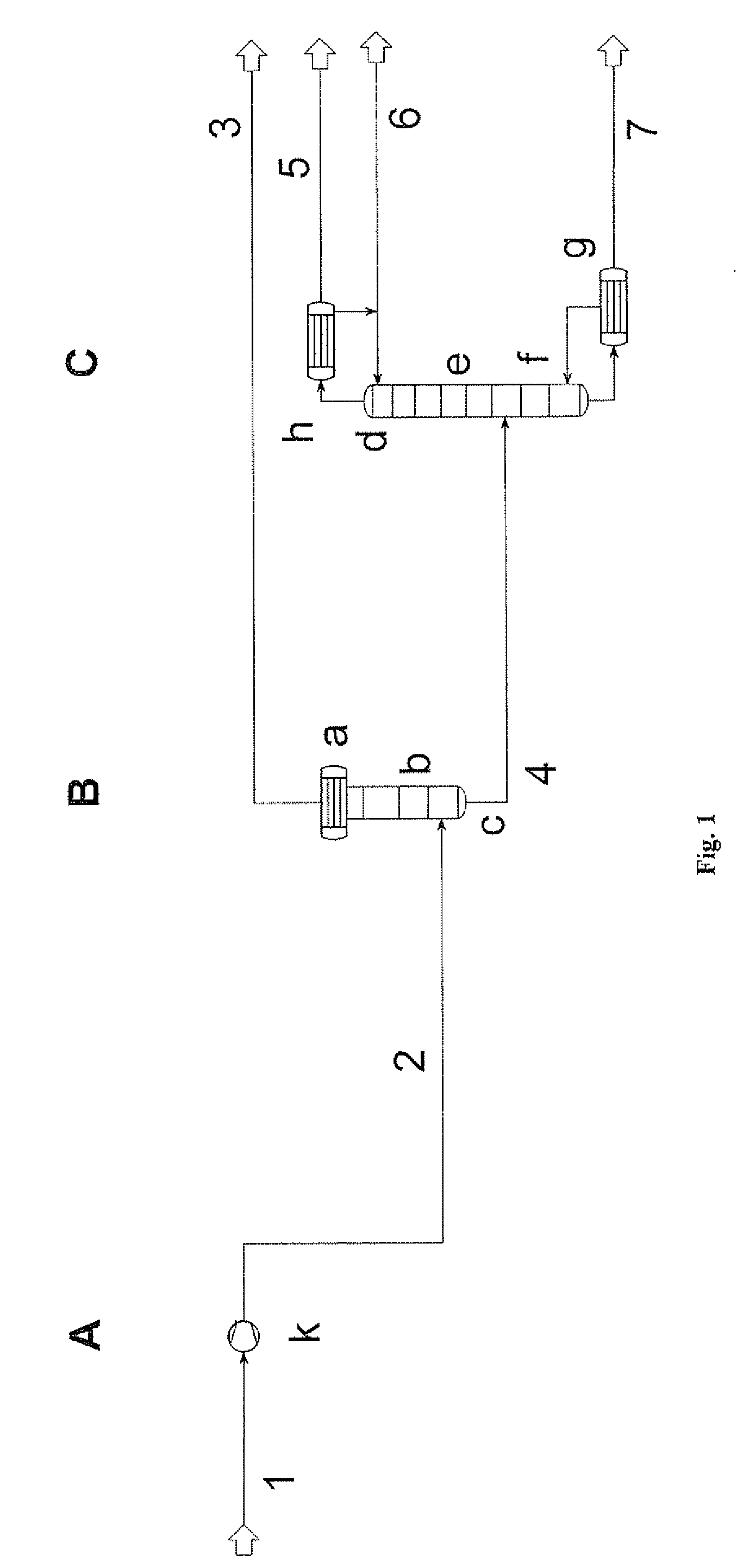Processes for Separating Chlorine from Chlorine-Containing Gas Streams
a technology of chlorine-containing gas and process, which is applied in the direction of dispersed particle separation, halogen/halogen-acid, inorganic chemistry, etc., can solve the problems of harmful substances or inert waste gas components, and achieve the effect of reducing the operating cost of chlorine-containing absorption and simplifying the work-up
- Summary
- Abstract
- Description
- Claims
- Application Information
AI Technical Summary
Benefits of technology
Problems solved by technology
Method used
Image
Examples
example 1
[0054]Referring to FIG. 1, the waste gas stream 1 of an upstream Deacon process (not shown), consisting of nitrogen, oxygen and carbon dioxide with a proportion of chlorine in the order of magnitude of 10 wt. %, is brought to a pressure of 35 bar (35,000 hPa) in the first stage A by means of a fan (compressor) k.
[0055]The compressed stream 2 is fed in the second stage B to a gas-liquid contact zone b in which the gas stream 2 is brought into contact with condensed chlorine. Above the gas-liquid contact zone b is a condenser a in which chlorine is condensed at a temperature of −42° C. The chlorine condensate is collected in the sump c of the gas-liquid contact zone b and fed as stream 4 to the third stage C. The uncondensed gases are discharged as stream 3 and are re-used or discarded as required, optionally after destruction of very small residual amounts of chlorine.
[0056]The condensate 4 is fed to a rectifying column d and applied in the middle region between the concentrating sec...
example 2
[0059]Referring to FIG. 2, the condensate stream 6′ from the rectifying column of stage C is vaporized in a first tubular heat exchanger 1 downstream of the fan k, and the waste gas stream coming from the first stage A is cooled thereby. The pre-cooled waste gas stream 2′ is passed through a recuperator (tubular heat exchanger i), in which heat is exchanged between the waste gas stream 2′ and the waste gas stream 3′ coming from the second stage B.
[0060]In addition, the gas stream 5′ leaving the third stage C is mixed with the gas stream 3′ leaving the head condenser a, and the mixture is passed through the recuperator i and then combined with the stream 6′ leaving the tubular heat exchanger 1 and discharged.
example 3
[0061]Referring to FIG. 3, heat is exchanged between the stream 2 and the stream 5 in a recuperator i downstream of the fan k. The stream 4 so obtained is fed directly to a rectifying column d. The stream 3 is discharged and re-used or discarded as required, optionally after destruction of very small residual amounts of chlorine that may remain.
[0062]In the column, the vapor stream produced in the vaporizer g is brought into contact, in a plurality of stages and countercurrently, with the vapor condensed in the head condenser h. Gas-liquid contact is effected by means of material-exchange plates (not shown).
[0063]The head condenser h is in the form of a partial condenser in order to allow inert components to be discharged in the gaseous state (stream 5). The condensate that forms is fed back to the column d. The chlorine concentrations at the column head (stream 5, FIG. 3) and at the column sump (stream 7) depend substantially on the energy supplied to the vaporizer and on the amoun...
PUM
 Login to View More
Login to View More Abstract
Description
Claims
Application Information
 Login to View More
Login to View More - R&D
- Intellectual Property
- Life Sciences
- Materials
- Tech Scout
- Unparalleled Data Quality
- Higher Quality Content
- 60% Fewer Hallucinations
Browse by: Latest US Patents, China's latest patents, Technical Efficacy Thesaurus, Application Domain, Technology Topic, Popular Technical Reports.
© 2025 PatSnap. All rights reserved.Legal|Privacy policy|Modern Slavery Act Transparency Statement|Sitemap|About US| Contact US: help@patsnap.com



